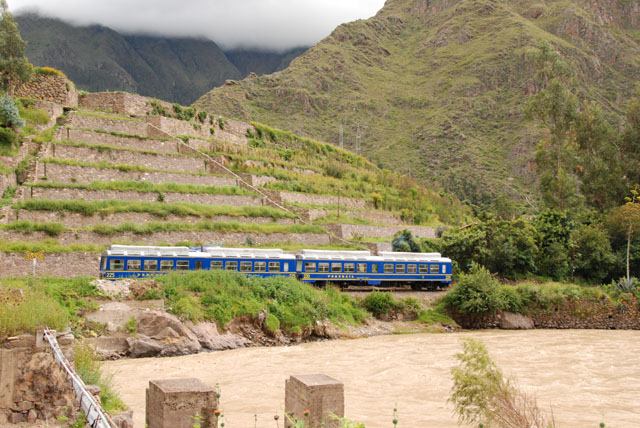
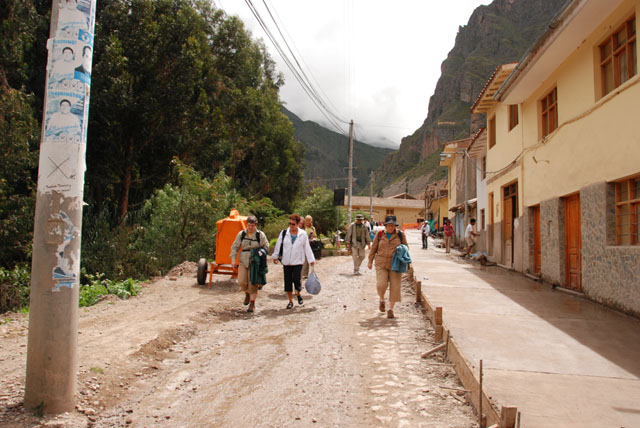
Along the Inca Road
March 27th & 28th, 2011 - Agua Calientes and Machu Picchu
Today we head for Aguas Calientes to tackle the hillsides of Machu Picchu. The day before had been filled with a range of experiences; sampling Guinea Pig and rafting the Urubamba River. Now it was time to prepare to visit one ofthe New Seven Modern Wonders of the World, Machu Picchu.
Compiled in 2001, the New Seven Modern Wonders of the world consists of the following monuments. Regardless of whether Machu Picchu is on your list or not it is a bucket list item to visit and see, just like the Seregeti and the Great Wall of China.
The train trip from Ollantaytambo to Aguas Calientes would be short, less than two hours. But, we would be traveling in a self-contained motorcar which had limited storage. This meant we had to repack our gear into an overnight bag for the two day visit. Our regular baggage would go back to Cusco while we spent the next two days in Aguas Calientes.


Our self-contained train and walking down to the station.
Once in Ollantaytambo we walked from the main plaza to the train station. The only road to the train station was under construction so we took our time getting to the station. The train arrived on time more or less and after a hectic boarding of the car and finding our seats we were off.
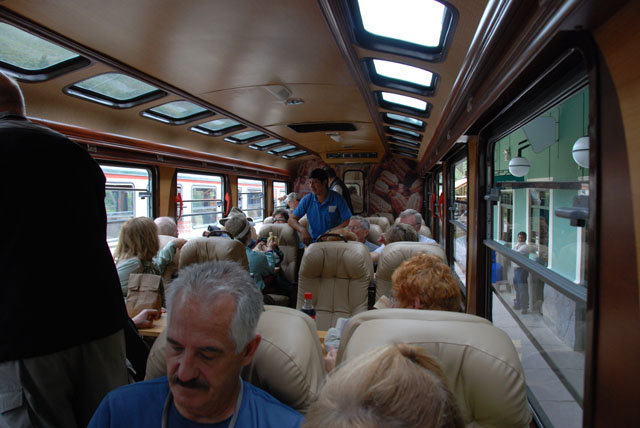
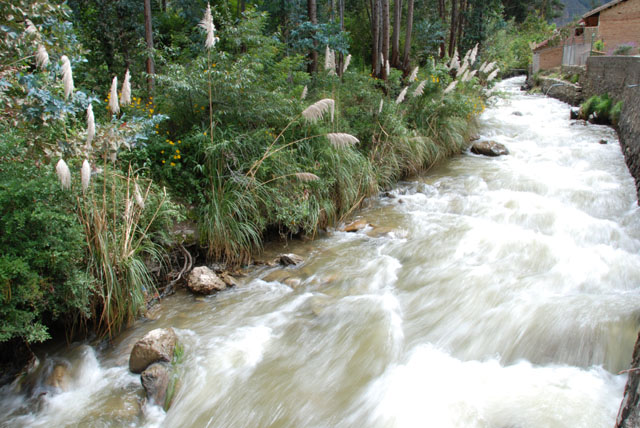
Inside the train. A another stream that empties into the Urumbamba River.
Confusion reigned supreme when we first boarded the car because it appeared there was no place for our bags. There were no over head bins and finally someone noticed that between the seats, which faced each other instead of being in a row, there was room to stuff a bag or pack. Once this problem was solved we settled back to enjoy the countryside.
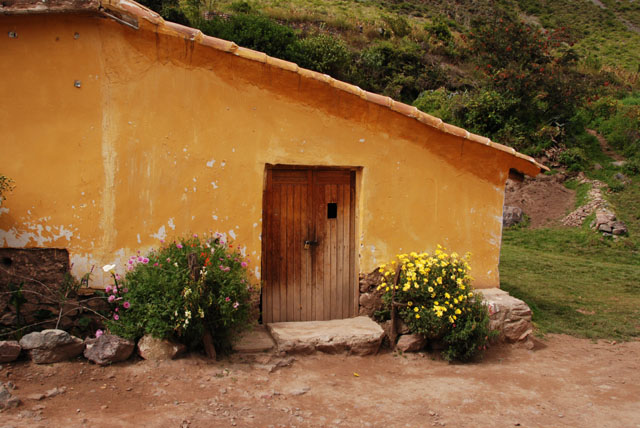
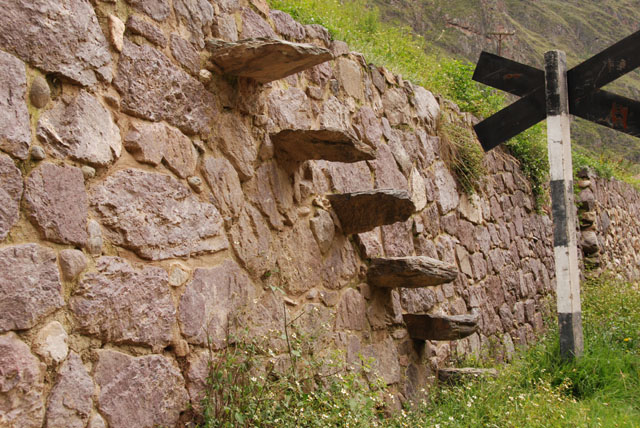
Along the tracks the old is found with the modern. A doorway to a home and ancient stone steps in a terrace built by the Inca.
On our left the Urubamba River continued to become a more violent river with class 6+ rapids, waterfalls and huge boulders kicking up standing waves over ten feet in height. The river narrows down to about 200 feet in width in some places. The flow of the river speeds up in these narrow confines and at least one person is lost each year trying to raft the river.
In no time we reached the town of Aguas Calientes, known for the hot springs which gave it its name. The town was settled in 1901 during the construction of the railroad along the river. At that time Machu Picchu was not known to the world. The rail line was completed in 1931.
Hiram Bingham, an American professor and explorer, announced the existance of Machu Picchu in 1911, after being led to the site by a local farmer. Bingham, however, was not the first non-native to find the site and cannot be said to have discovered Machu Picchu (you can't discover something that already exists, you can uncover it or bring it back to life, but no discovery credit). The site, for which there is no definitive reason as to why the Inca constructed it in the first place, was started in the early 1500; Bingham simply made its presence known to the world outside the Sacred Valley.
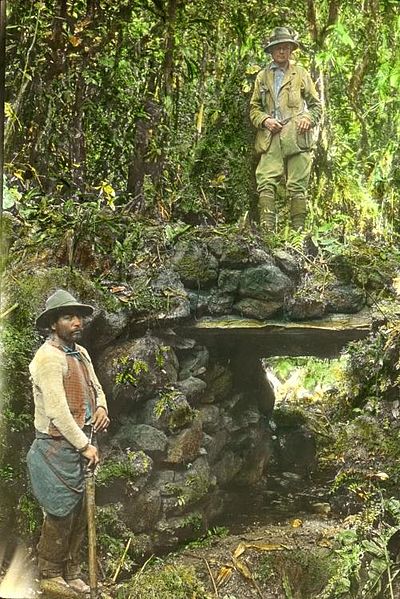
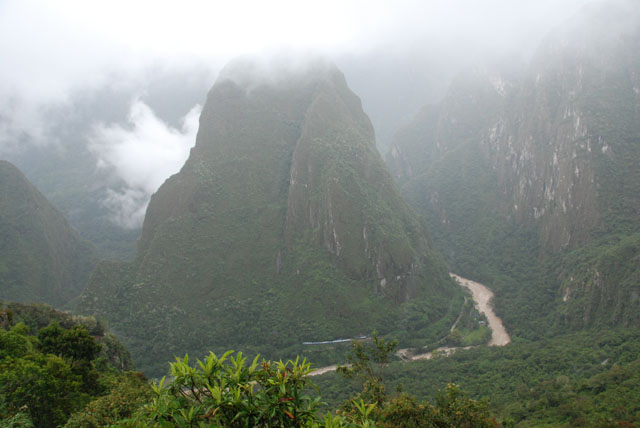
Hiram Bingham during the search for Machu Picchu. The steep canyon walls and vegetation hid the site for centuries.
While Bingham was the first person to bring word of the ruins to the outside world, others had seen the ruins prior to Bingham's 1911 visit. There is evidence Enrique Palma, Gabino Sánchez, and Agustín Lizárraga left their names engraved on one of the rocks at Machu Picchu on 14 July 1901. In 1904, an engineer named Franklin supposedly spotted the ruins from a distant mountain during a survey mission. He told Thomas Payne, an English Christian missionary living in the region, about the site. Payne's family reports that in 1906, Payne and fellow missionary Stuart E. McNairn (1867–1956) climbed up to the ruins sometime later.
The site may have been discovered and plundered as early as 1867 by a German businessman, Augusto Berns. There is also evidence another German, an engineer, J. M. von Hassel, arrived even earlier. Maps found by historians show references to Machu Picchu as early as 1874. Of course, the site was known to local farmers for years and there was no reason to tell anyone else what was on the mountain top.
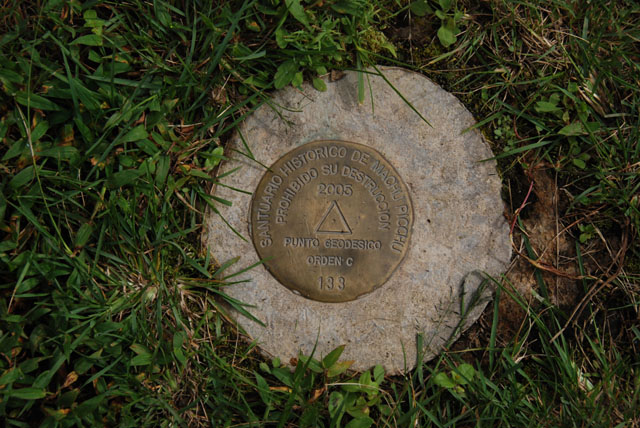
Geodesic marker identifying Machu Picchu as a historical site. This marker is on the Inca Trail by the Sun Gate entrance to the site.
But for Hiram Bingham Aguas Calientes might still be a small railroad and construction town. Situated where the Urubamba and an adjacent smaller stream meet, the near-by hot springs were its only claim to fame until 1911. The town became a starting point for tourists to visit Machu Picchu. More intrepid travelers use Aguas Calientes as a base camp to hike the Inca Trail and today hikers by the scores can be seen in the town; returning from their four day hikes or getting ready to see if they can master hiking at elevations over 10,000 feet.
Today, aside from the railroad station, the covered market and one major street are all that comprise this small "gold-rush" looking town. There are no cars on the streets, just carts and wagons. The roar of the river is constantly in the background, regardless of where you are in the town. Once you realize what the noise is it becomes nothing more than background noise.
Despite having a wet and dry season rain is a constant in Aguas Calientes and Machu Picchu. We were fortunate the rain did not disappoint us, it was raining when we pulled into the station. After a quick inventory of all members we boarded the "Machu Picchu Shuttle" bus which took us from the river floor up to the site. 12 switchbacks later we were at the entrance of Machu Picchu, a world heritage site, along with several hundred of our newly found closest friends!
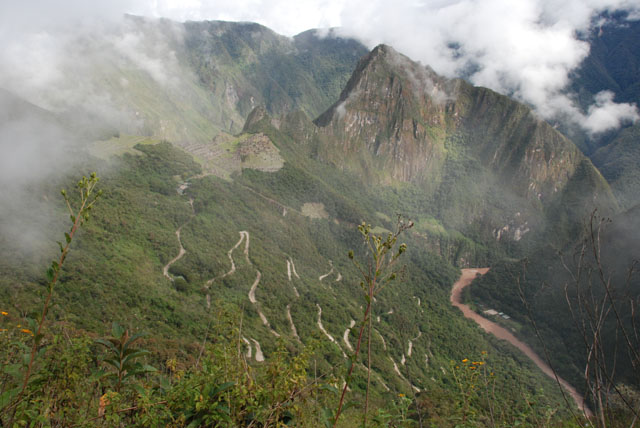
The road from the valley floor to the site.
The light drizzle was with us at the site's entrance, ah, it must be the wet season! Walking throught the park entrance, where you must show your passport and ticket to enter, rain clouds and mist slowly drifted across the path. The sensation was like being in airplane flying through the clouds, though in this case one was walking through the clouds. The trail narrowed down to where only two people could walk side by side and then, around a large rock the city of Machu Picchu came into view.
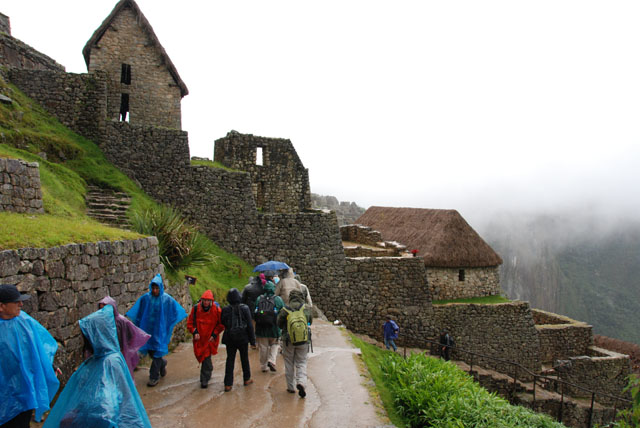
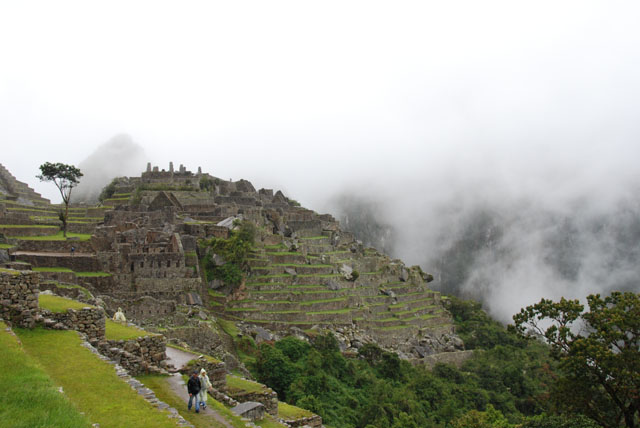
Our first views of Machu Picchu. Huayna Picchu, the Young Mountain is hidden in the mist.
There are few sights in the world, both natural and man-made, which can move you to tears, make you realize how insignificance you are or just make you stop and stare and ask, how in the hell....? Seeing Machu Picchu in the afternoon with clouds and the mist moving about is one of those sights. After the initial shock that we were in the clouds with what was the Inca's Swan Song we began exploring the site.
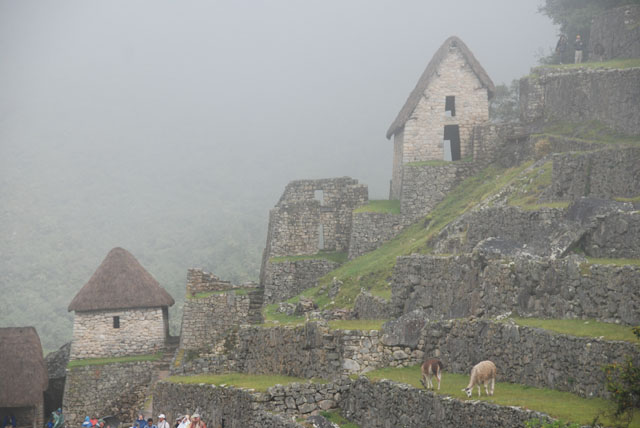
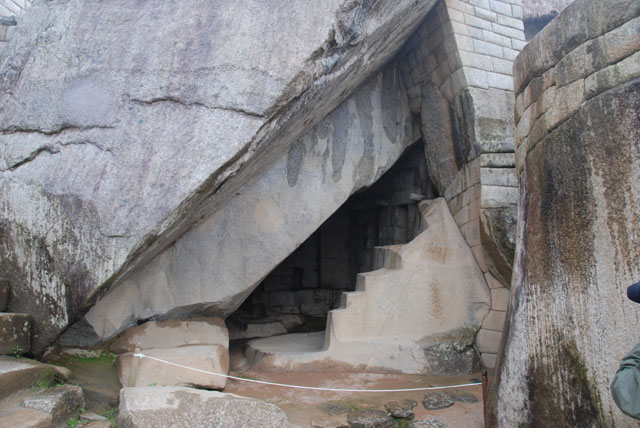
Llamas add a touch of the past as they graze on the terraces. The Royal Tomb - a name coined by Bingham, it may or may not have been a tomb. However, over 100 skeletal remains were found in the structure which was constructed around a living rock. Today it's still unknown what the purpose of the area was for.
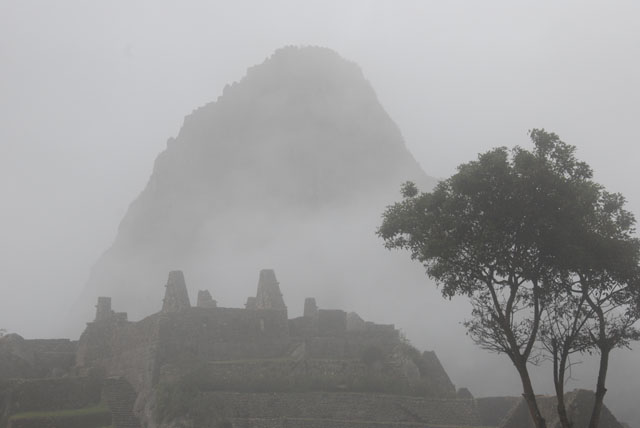
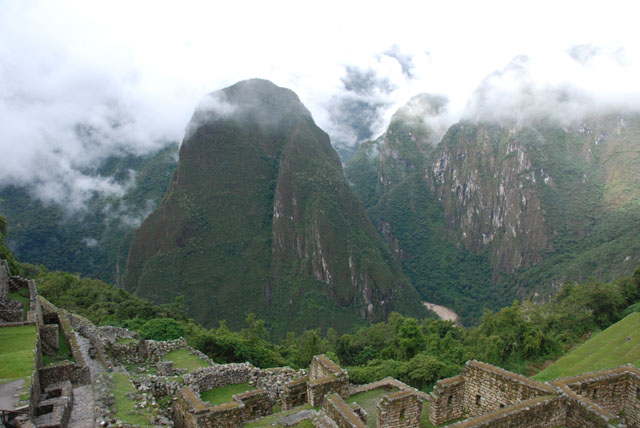
Huayna Picchu, the hidden mountain still in the clouds and then later, sunlight!
The question as to why Machu Picchu was built has elicited many responses.
At this point in modern time there is no real answer, nor should there be a final answer.
The site was built over 2,000 feet above the Urubamga River. The mountain slopes to the site are steep, most at a 60 degree angle. Located 50 miles northwest of Cusco, capital of the Incas, it may have been an estate for the Inca emperor Pachacuti. Construction at the site may have begun in 1400 AD and then abandoned during the Spanish Conquest. The Spanish never found it, which is fortunate because physically the site remained intact until Bingham found the site.
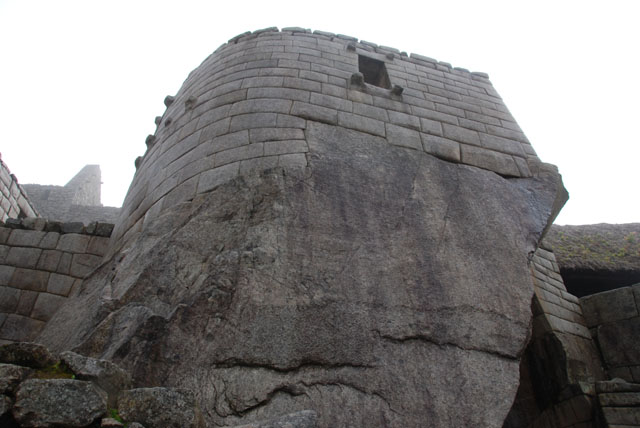
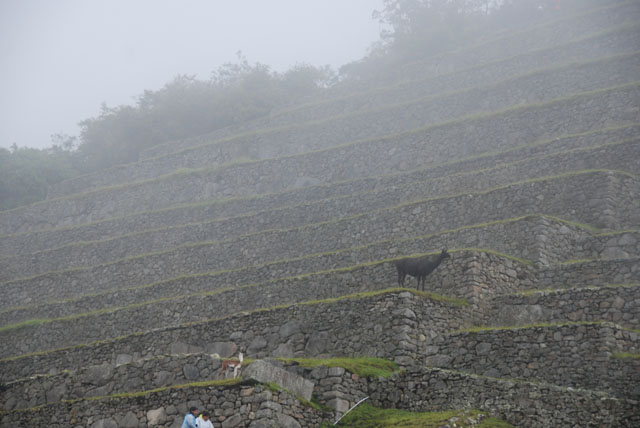
The Temple of the sun from a terrace. The large number of terraces at the site indicate Machu Picchu grew more food than was needed. This surplus of grain may have been the Inca's way of using the mountain citadel as a last-ditch bastion.
Maybe it really was suppose to be a "mountain hide-away!" Who really knows?
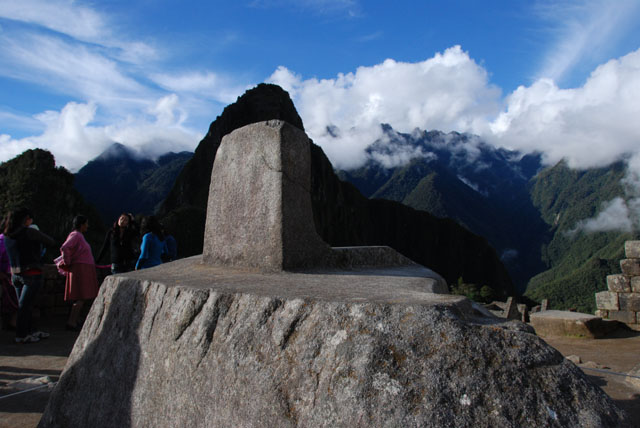
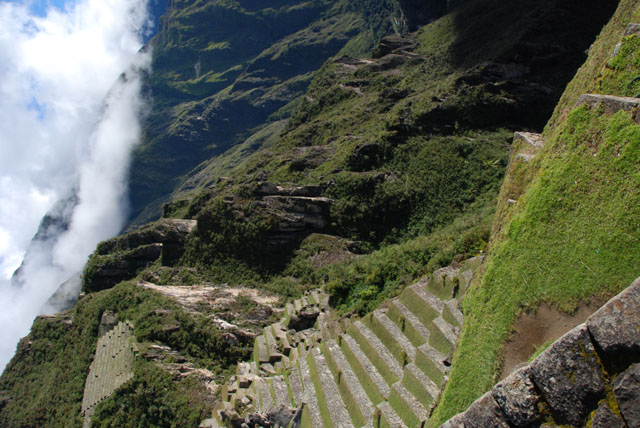
The sun stone, this was the Inca equinox alarm clock. Terrance, some hundreds of feet below the main village, ring Machu Picchu.
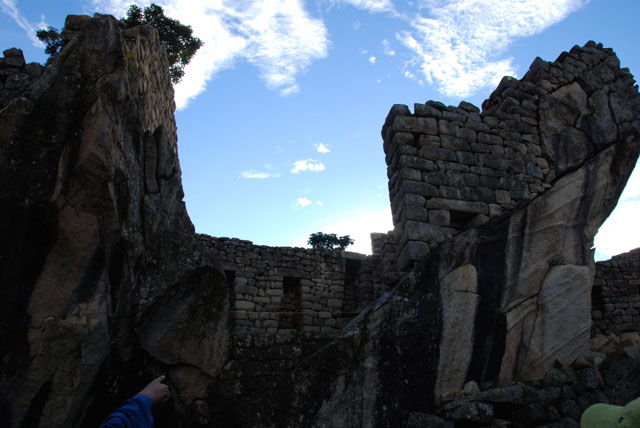
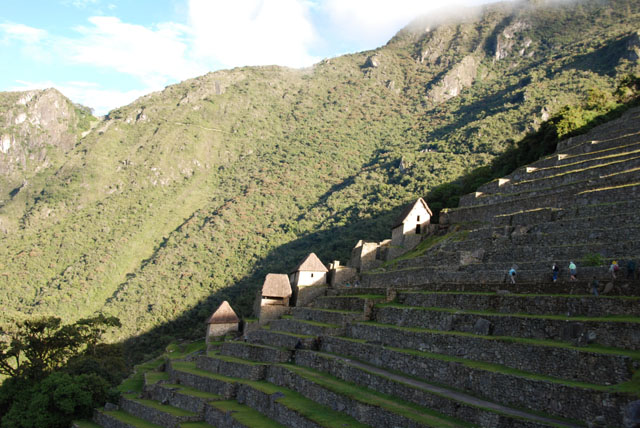
The condor stone and more graineries with more terraces.
16th century Spanish records reveal there was knowledge of Inca sites in the Sacred Valley, but no real effort was made by the Spanish to find them. The only real effort the Spanish and the church concentrated during the conquest was:
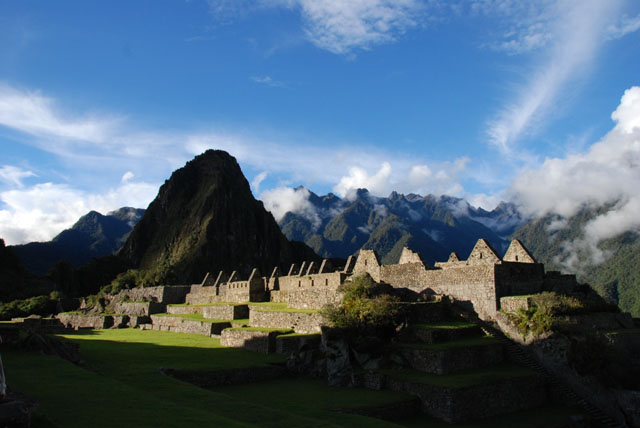
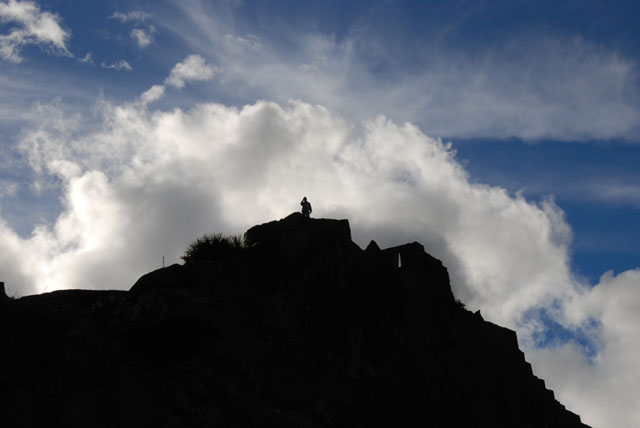
Late in the afternoon the shadows began to tell more tales of life in Machu Picchu.
Today all we can think about is the man-power and skill that went into designing, manufacturing, moving and constructing rock at these elevations into a site which was in complete harmony with its environment. Many of Machu Picchu's iconic landmarks are constructed around living rock. Living rock, for those not accustomed to the term means working around an existing physical item. The living item can be a rock, a tree, a river or even a stream. The American architech, Frank Lloyd Wright was foremost in designing his homes in such an environment.
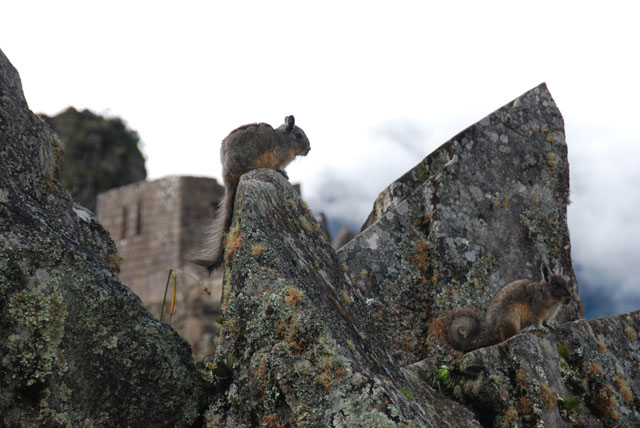
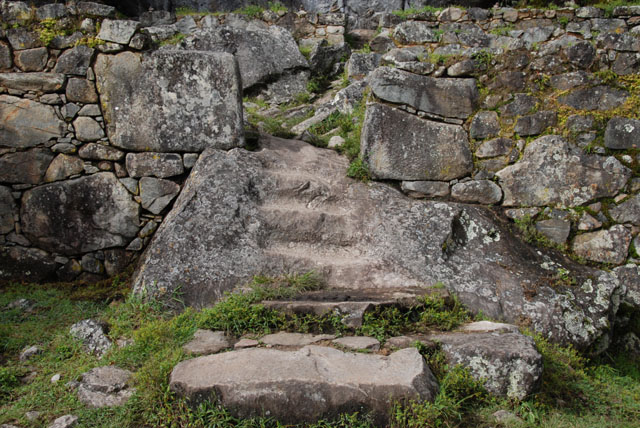
Machu Picchu Arboreal Chinchilla Rats Cuscomys oblativus surveying the site. Where possible the Inca used living rock even as steps into a ceremonial area. Working with nature is an element quite foreign to today's engineers and architects. I doubt we will ever see it again.
Our two day visit to Machu Picchu was spectacular. Rain the first day; clear in the afternoon. The second day was even more spectacular in terms of weather. Our group was free to go their separate ways on the second day. Some decided to climb Machu Picchu. Others chose to walk around the main compound. Joan and I and a few others decided to walk to the Sun Gate, one of the site's guard posts located 2,000 feet above the main site.
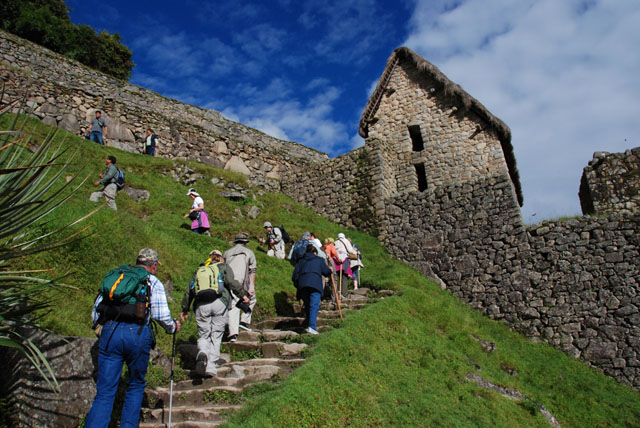
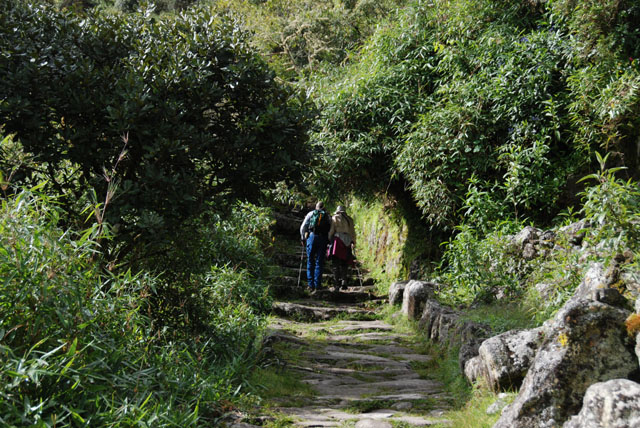
Getting to the Sun Gate is all uphill. All uphill!
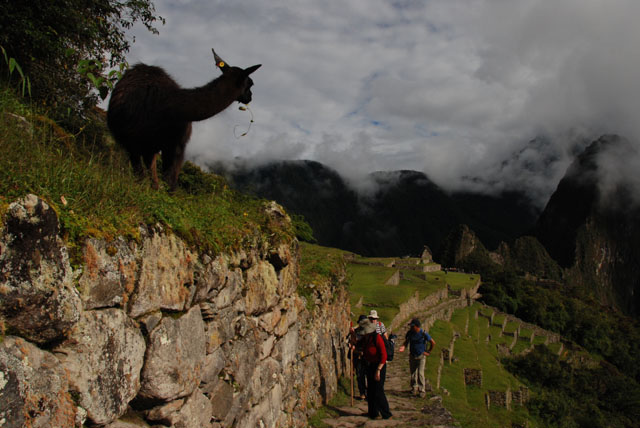
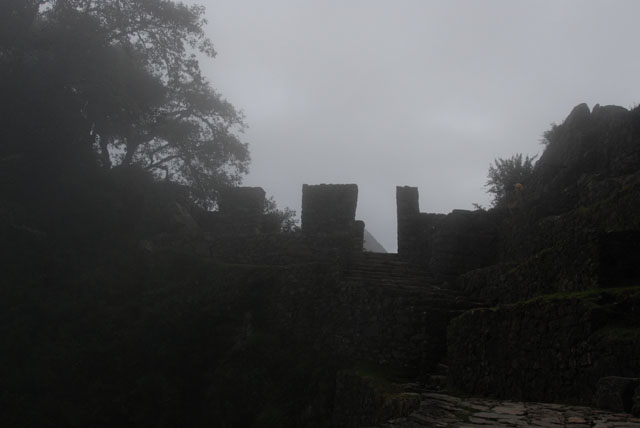
A wayward Llama kept an eye on us as we made our way to the Sun Gate. Machu Picchu got smaller and smaller the higher we got.
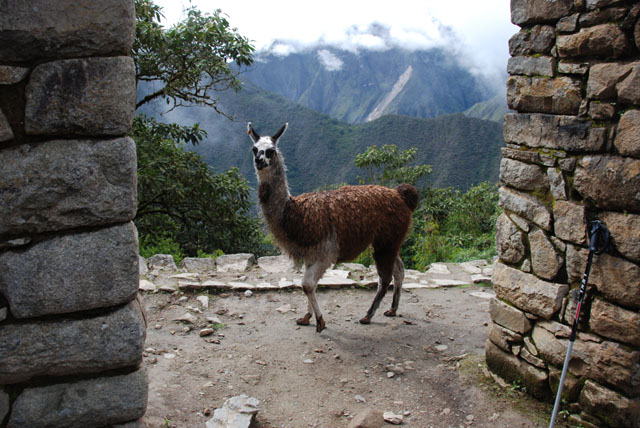
The Llama greeted us at the Sun Gate
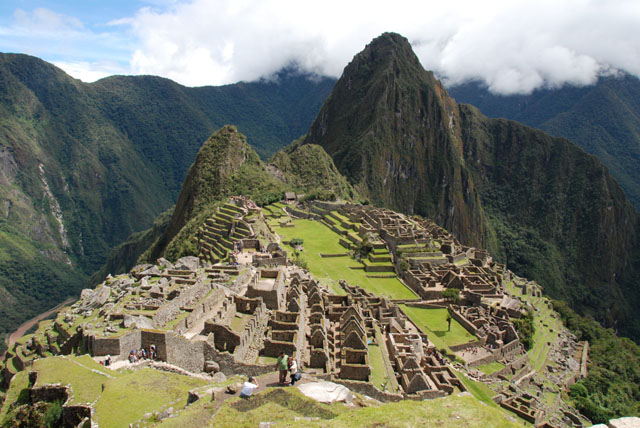
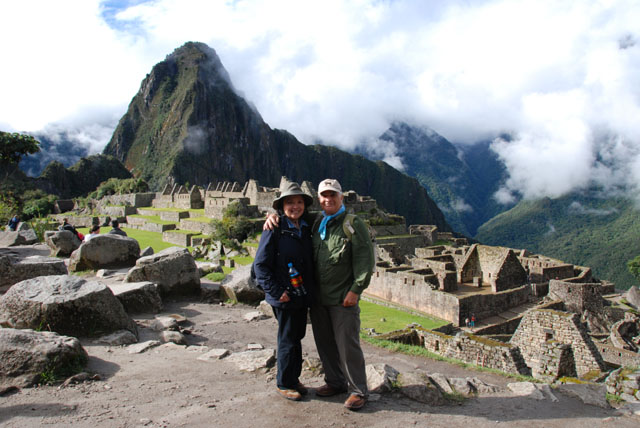
Machu Picchu in sunlight. Our final day was bathed in sunlight and it was a fitting end to a memorable visit.
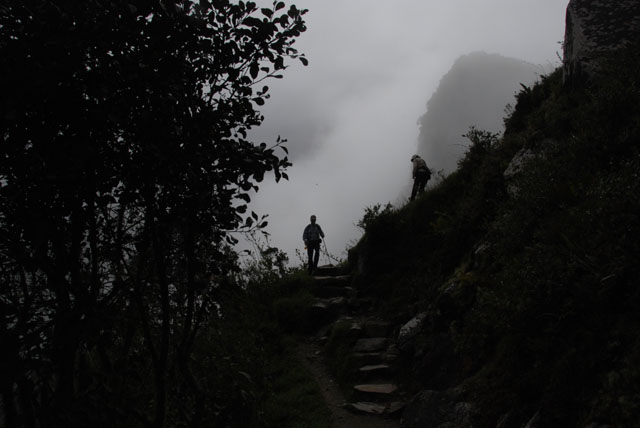
Walking back down from the Sun Gate.
We boarded the train to return to Ollataytambo and the bus which would take us back to Cusco. The trip back to Cusco was in the late afternoon and by sunset we were within the city lights of Cusco.
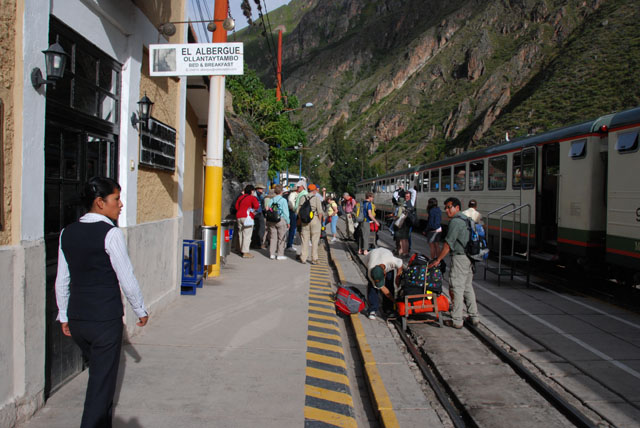
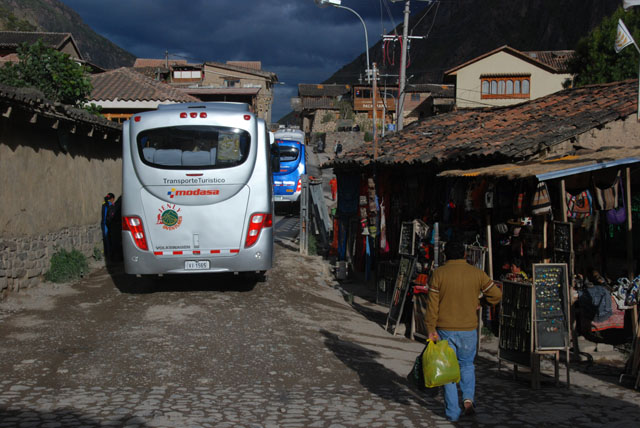
Picking up our gear at the rail station in Ollantaytambo and our bus getting ready to go back to Cusco.
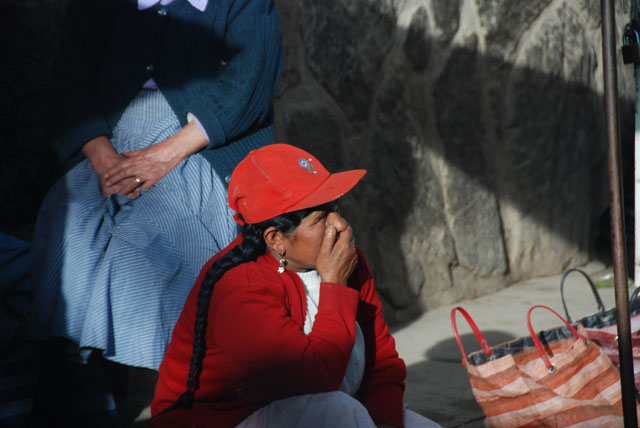
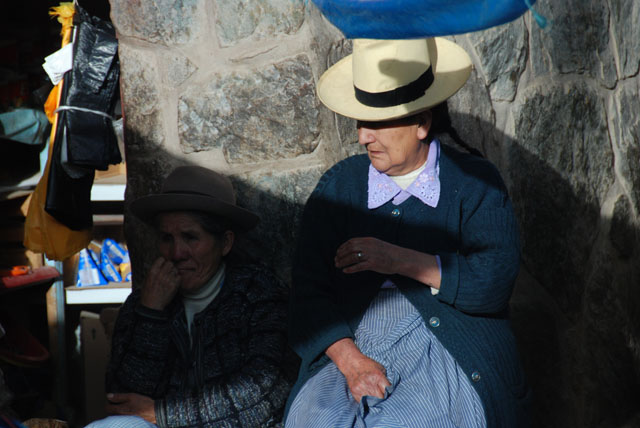
The ladies at Ollantaytambo market.
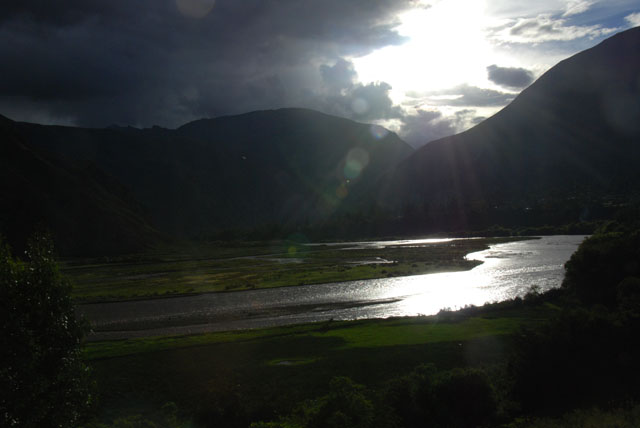
Sacred Valley in the afternoon.
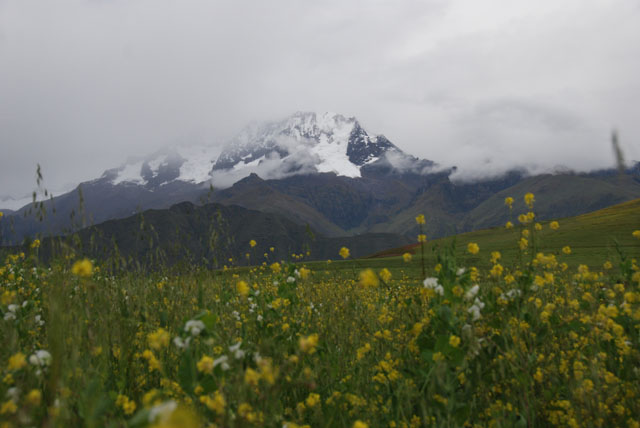
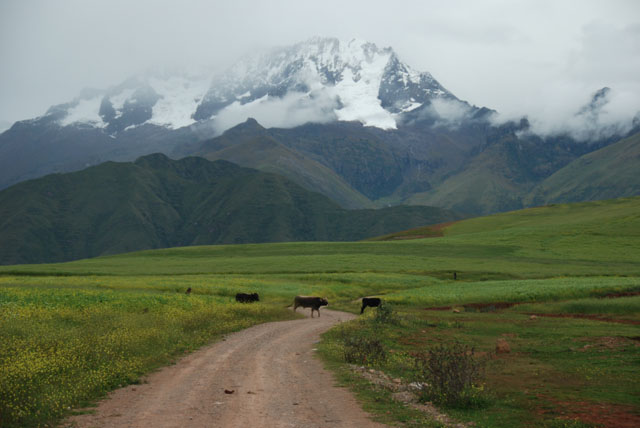
The Andes near Ollantaytambo.
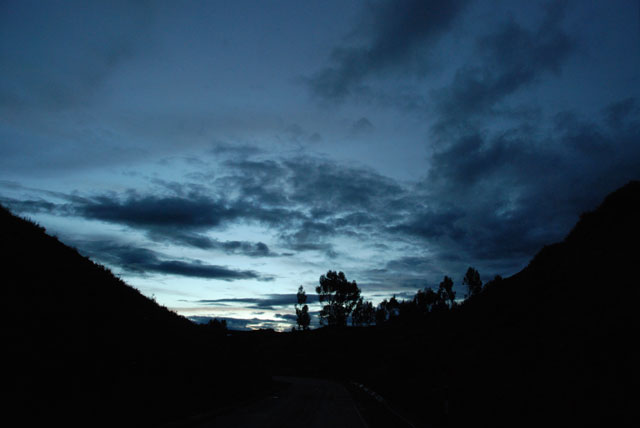
Night falls in the Sacred Valley.
More Galván Trips & Travel Posts
Copyright 2011 Anthony Galván III